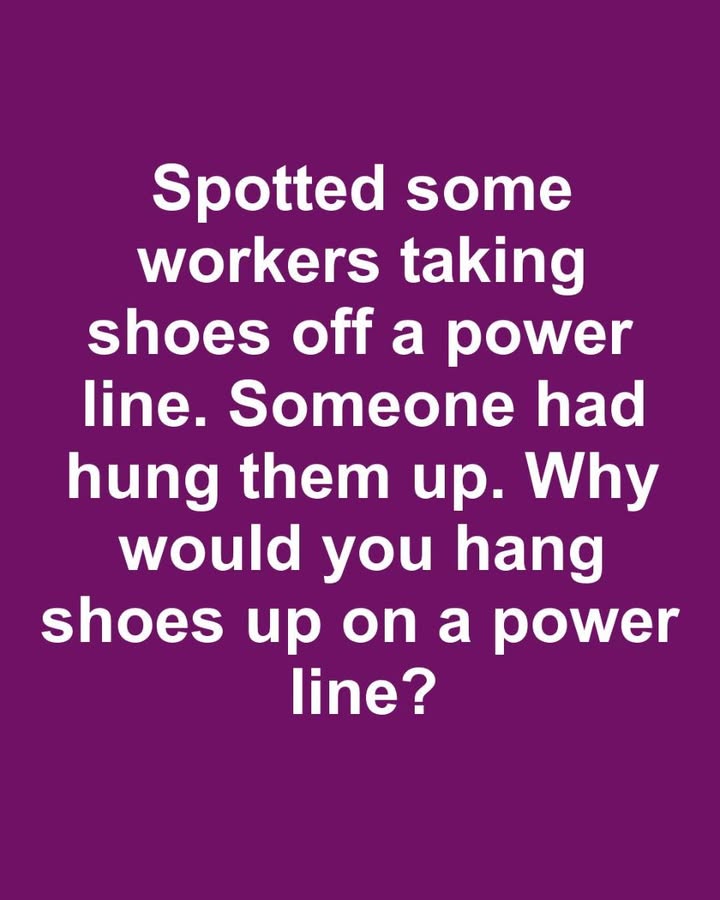The strange sight of shoes hanging from power lines is something many people have come across while walking or driving through urban or suburban neighborhoods, and while it might seem like just another random act of mischief, this odd visual has sparked a wide range of interpretations, stories, and cultural theories that go far beyond a simple prank.

Though it appears frequently and in many places, the act of throwing shoes onto power lines has deeper roots and a variety of meanings depending on the context, location, and even the time period in which it happens. Some believe this curious practice began during wartime, when soldiers would toss their boots onto overhead wires to mark the end of their service or deployment as a symbolic gesture of transition or closure. Others argue that it originated within street culture, particularly as a way for gangs to mark territory or claim certain areas, although the evidence supporting this is largely anecdotal and tends to vary by region. Beyond these historical possibilities, cultural interpretations of this phenomenon are equally rich and diverse.
In some communities, it’s seen as a form of folk expression or even street art, used to send messages, invoke public reactions, or reflect social commentary. Symbolically, shoes can represent a wide array of ideas—moving on from one phase of life to another, shedding the past, or commemorating someone’s life or death. In this sense, the shoes might serve as a physical metaphor for transformation, rebellion, remembrance, or community identity. Many theories attempt to explain the reasons behind shoe-tossing. For teenagers, it may be a spontaneous way to celebrate milestones like graduation or the end of a school year, a sort of unofficial ritual marking growth and change. Others speculate that the practice is tied to gang activity or drug trafficking, with shoes marking specific zones or indicating illicit activity, although these claims often stem from urban myths and lack solid evidence.
Some stories even suggest that the shoes belonged to someone who passed away, and throwing them over the wires is either a tribute or, in some interpretations, a form of disrespect. These myths shift depending on the community and have helped build the mystery surrounding the shoes. Despite the curiosity and symbolic intrigue, hanging shoes on power lines does come with real safety concerns. The added weight can strain the power lines, potentially causing outages, damage, or even fires.
Utility workers tasked with removing the shoes face hazardous conditions, especially when dealing with live electrical equipment. Public safety officials often warn against this practice, citing both the risks to infrastructure and the danger to workers who must address the issue. In several cities, including parts of Los Angeles, municipal teams have been called in to remove shoes after residents reported recurring power disruptions linked to shoe-laden lines. These interventions, while necessary, have also sparked broader discussions about the motives behind the acts—whether they were acts of vandalism, youthful pranks, or misguided attempts at urban art. Community responses to these dangling shoes vary considerably. Some people view them as harmless and even amusing symbols of youth or rebellion, while others consider them visual pollution or evidence of gang presence, making them feel unsafe in their own neighborhoods. Local groups sometimes push for cleanup initiatives to improve community appearance and promote safety, while a few residents advocate for preserving the shoes as quirky symbols of local character and creativity. From a legal standpoint, hanging anything on public infrastructure is typically considered vandalism and can lead to fines or penalties. Law enforcement agencies and utility companies often work together to prevent these incidents and inform the public about the legal and safety consequences of tampering with electrical equipment. Educational programs and community outreach efforts are used in many areas to raise awareness and encourage residents to report such occurrences for timely removal. Despite the wide range of meanings people assign to the sight of shoes on power lines, the practice remains a fascinating example of how ordinary objects can take on extraordinary significance depending on cultural context, historical associations, and personal interpretation. Understanding the motivations behind this odd tradition helps shed light on how people express identity, emotion, and resistance through unconventional public displays, revealing the complexity of modern urban life and the symbolic power we assign to everyday acts.





